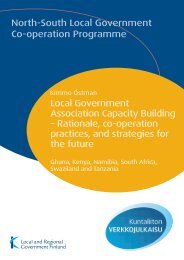E-READINESS QUESTIONNAIRE FOR NORTH ... - Kunnat.net
E-READINESS QUESTIONNAIRE FOR NORTH ... - Kunnat.net
E-READINESS QUESTIONNAIRE FOR NORTH ... - Kunnat.net
Create successful ePaper yourself
Turn your PDF publications into a flip-book with our unique Google optimized e-Paper software.
2.10 E-Inclusion<br />
24<br />
range of online services. This does not only raise the trust level of the citizens in the<br />
government but also saves a lot of time by providing services on a 24/7 basis which<br />
would have otherwise been done over the conventional ‘counters’ only during the<br />
working hours of the government 24 .<br />
Phase III: Transaction<br />
While in the Interaction phase, the citizen is able to exchange information online and<br />
get details of the procedures involved, when it comes to actually conducting the transaction,<br />
he/she has to resort to the conventional means. However, in Phase 3, this situation<br />
is amended and this phase involves establishing websites and other applications<br />
that allow users to conduct transactions online. In other words, the user is able to avail<br />
the service online in the complete sense. Online mo<strong>net</strong>ary transaction and payments is<br />
a crucial component of this phase since the citizen can carry out the transaction without<br />
having to even visit the government offi ce. This phase demonstrates the advancements<br />
of technologies such as digital certifi cates and payment gateways and results in a<br />
long term cost saving and improvement in productivity. Services such as online booking<br />
and payment of travel tickets, payment of taxes, land registration, renewal of ID<br />
cards, payment of utility bills etc which require transaction can be effectively provided<br />
in this phase through citizen kiosks and web enabled applications24 .<br />
Phase IV: Transformation<br />
This phase alludes to the stage where government has gone through the full transformation<br />
process and all the citizen services are being made available online through a<br />
single ‘virtual’ counter round the clock. In other words, in this stage the capacity to<br />
instantly access any service in a ‘unifi ed package’ is provided to the citizen. Ministerial/<br />
departmental/agency lines of demarcation are removed and services are clustered along<br />
common needs. Providing such fully integrated services shall require broad organizational<br />
change, aligning organizational setup with the new capacities and integrating<br />
the back-end operations and infrastructure in such a coherent and seamless manner<br />
that the government can effectively acquire the distinction of being called a ‘digital<br />
state’ 24 .<br />
The value of E-government can be limited by disparities in access to ICTs and digital<br />
literacy. Poorer people and residents of rural areas and other disadvantaged communities<br />
are less likely to have Inter<strong>net</strong> access, less likely to be e-Literate, and therefore less<br />
likely to make use of electronic information and services. In addition, citizens with<br />
some form of physical disability are also at risk of being left behind, unless their needs<br />
are specifi cally addressed in E-government strategies. Addressing equity issues throughout<br />
the planning and implementation of E-government projects can help ensure that<br />
traditionally marginalized citizens will benefi t from online services, rather than becoming<br />
further isolated from the digital economy 24 .<br />
2.11 E-Government Tools and Technologies<br />
Tools and technologies suited to E-government are undergoing intensive development<br />
by actors in both the private and the public sectors. Useful tools and technologies include<br />
both proprietary and open source platforms and applications. Many of the tools<br />
that governments are adopting were developed originally for commercial use and are<br />
available off-the-shelf or in open source format. Governments often contract with private<br />
sector consulting services to design and implement E-government applications,<br />
platforms, and infrastructure. They may also outsource to the private sector the opera-




